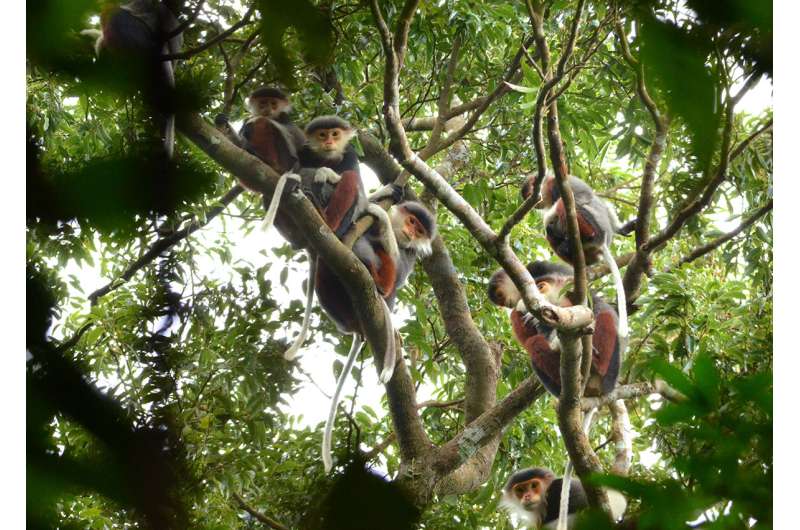August 30, 2016 report
Gut biome of monkeys found to change when they are kept in captivity

(Phys.org)—An international team of researchers has found that when monkeys are kept in captivity, their gut biomes become less diverse. In a paper published in Proceedings of the National Academy of Sciences, the team describes how they collected fecal samples from monkeys from several sites and compared DNA analysis of organisms living in their guts to learn more about the impact of a changing gut biome.
Scientists have known for some time that the human gut biome is far less diverse than it once was—most in the field believe this is due both to the use of antibiotics and a reduction in consumption of a variety of fibrous foods. The gut biome helps us digest our foods, which means that the greater diversity of food we eat, the greater diversity of microbes we must have in order to digest them. To gain a better understanding of this relationship, the researchers chose to study the monkey biome because it is possible to obtain samples from individuals that live in the wild as well as in captivity.
To compare gut biomes, the researchers collected fecal samples over a nine-month period from wild and zoo-housed red-shanked doucs and mantled howlers—two types of monkey. The samples were then analyzed using DNA sampling techniques to identify all the types of microbes living in a given monkey gut. The team then compared the average number of individual microbes for the groups. They found that the wild monkeys had a much more diverse gut microbiome—they also noted that they ate a far more varied diet; the wild doucs, for example, ate approximately 57 plant species, while those that lived in a Vietnamese zoo were given just 15 species. Those that lived in American zoos were fed just one. The researchers also noted that the gut biomes of the two monkey species living in captivity were far more alike than those that lived in the wild and that the gut biomes of monkeys living in a zoo was very similar to the human gut biome of people eating a western diet.
What is still not clear, however, is whether having a less diverse gut biome is good or bad—some evidence has suggested monkeys in captivity experience gut-related health issues, but to date, a comparative analysis of monkeys living in the wild versus those in zoos has not been done.
More information: Jonathan B. Clayton et al. Captivity humanizes the primate microbiome, Proceedings of the National Academy of Sciences (2016). DOI: 10.1073/pnas.1521835113
Abstract
The primate gastrointestinal tract is home to trillions of bacteria, whose composition is associated with numerous metabolic, autoimmune, and infectious human diseases. Although there is increasing evidence that modern and Westernized societies are associated with dramatic loss of natural human gut microbiome diversity, the causes and consequences of such loss are challenging to study. Here we use nonhuman primates (NHPs) as a model system for studying the effects of emigration and lifestyle disruption on the human gut microbiome. Using 16S rRNA gene sequencing in two model NHP species, we show that although different primate species have distinctive signature microbiota in the wild, in captivity they lose their native microbes and become colonized with Prevotella and Bacteroides, the dominant genera in the modern human gut microbiome. We confirm that captive individuals from eight other NHP species in a different zoo show the same pattern of convergence, and that semicaptive primates housed in a sanctuary represent an intermediate microbiome state between wild and captive. Using deep shotgun sequencing, chemical dietary analysis, and chloroplast relative abundance, we show that decreasing dietary fiber and plant content are associated with the captive primate microbiome. Finally, in a meta-analysis including published human data, we show that captivity has a parallel effect on the NHP gut microbiome to that of Westernization in humans. These results demonstrate that captivity and lifestyle disruption cause primates to lose native microbiota and converge along an axis toward the modern human microbiome.
Journal information: Proceedings of the National Academy of Sciences
© 2016 Phys.org


















